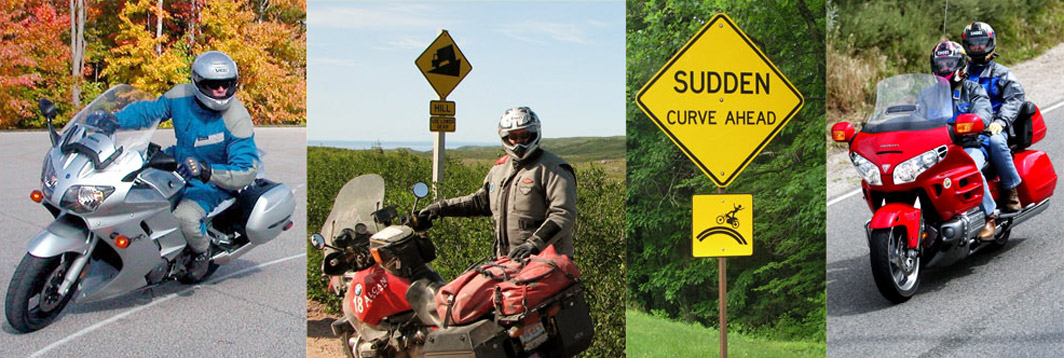Helmet Type/Style (Including Novelty Helmets)
This section contains research related to helmet styles or types, including research on novelty helmets. In the U.S. a novelty helmet is any helmet not meeting the Department of Transportation standard. Common styles of helmets worn include the full face helmet, the open face or ¾ helmet and the half coverage helmet.
Most countries and some U.S. states have laws requiring all or some riders to wear a helmet. Most U.S. states that do have laws, require that the helmet meet Federal Department of Transportation (DOT) standards but few, if any have regulations regarding the type of helmet that must be worn or the appropriate use of helmets.
While helmets have been shown to reduce the risk of head injury by 69% and the risk of death by 42% for motorcyclists involved in accidents (Cochrane Review) these types of studies seldom distinguish the protective values of various styles and despite this evidence many American riders choose to wear uncertified novelty helmets.
Helmet Type & Style Research Studies
2022 – “Full-face Motorcycle Helmets to Reduce Injury and Death: A systematic review, meta-analysis, and practice management guideline from the Eastern Association for the Surgery of Trauma” Abstract
While the research is clear that motorcycle helmets reduce mortality and morbidity, no guidelines specify which is safest. The authors did a review of the literature seeking to determine if full-face helmets reduce injury and death and concluded full-face helmets significantly reduce traumatic brain injury, significantly reduce facial fracture and reduce severity of head, neck, and facial injury.
2021 – “Motorcycle Helmet Selection and Usage for Improved Safety: A Systematic Review on the Protective Effects of Helmet Type and Fastening” – ABSTRACT
The goal of this systematic review is to assess which characteristics of helmet design and use showed a positive influence on rider safety, in order to provide insights to improve end-user helmet usage. Most studies agreed that full-face helmets provide higher protection in comparison with other standard helmets, especially for facial injuries, and no negative influence with respect to neck and spinal injuries.
2020 – “Are Full-face Helmets the Most Effective in Preventing Head and Neck Injury in Motorcycle Accidents? A meta-analysis” Abstract
Although it is well documented that helmets can provide protection against injury, there is limited evidence available regarding which type of helmet best protects against head and neck injuries in this setting. This is an abstract of a literature review aimed to determine the most effective helmet type in preventing head and cervical injuries in motorcycle accidents. The study concluded full-face helmets reduced head and neck injuries in motorcycle accidents to a greater extent than other types of helmets.
2016 – “The Preventive Effect of Head Injury by Helmet Type in Motorcycle Crashes: A Rural Korean Single-Center Observational Study”
The goal of this study was to determine the preventive effect on head injury by helmet type: full face helmet (FFH), open face helmet (OFH), and half-coverage helmet (HCH). FFHs and OFHs reduce the risk of head injury, and FFHs have a more preventive effect on head injury in motorcycle crashes.
2015 – “The Effect of Various Types of Motorcycle Helmets on Cervical Spine Injury in Head Injury Patients: A Multi-center Study in Taiwan”
The relationship between cervical spine injury (CSI) and helmet in head injury (HI) patients following motorcycle crashes is crucial. Controversy still exists; therefore, in this study the researchers evaluated the effect of various types of helmets on CSI in HI patients following motorcycle crashes and researched the mechanism of this effect. The authors conclude wearing full-coverage and partial-coverage helmets significantly reduced the risk of CSI among HI patients following motorcycle crashes.
2014 – “How Safe Is Your Motorcycle Helmet?”
Motorcycle crash helmets do not totally prevent head and facial trauma. The aim of this study was to investigate if protection offered by helmets differs according to helmet type. The results show Facial Injury Severity Scale score was significantly higher for unhelmeted riders compared with fullface helmet riders and no difference between unhelmeted riders and open-face helmet users. Results for Traumatic Brain Injury were statistically greater for those wearing open-face helmets compared with full-face helmets.
2011 – “Effectiveness of Different Types of Motorcycle Helmets and Effects of their Improper Use on Head Injuries”
The researchers conclude: This study demonstrates that the type and fastening status of a helmet can affect the helmet’s effectiveness in preventing head injuries. For a long time, injury prevention workers have focused on whether or not motorcycle riders wear a helmet, rather than on which helmet type should be worn or how the helmet is worn. Now it is high time to promote legislation that requires motorcycle riders to wear safer helmets (e.g. full-face helmets) as well as to fasten the helmets properly.
2010 – “Motorcycle Helmet Impact Response: Comparison of Helmet Type and Impact Severity”
The goal of this study was to compare, over a wide range of impact speeds, the impact attenuation performance of a number of common helmets varying from an inexpensive, non-approved beanie helmet to high-end, DOT- and Snell-approved full-face helmets. Based on these data, beanie helmets provide scant protection against head injury. The approved helmets behaved similarly at impact severities below 150 J, but diverged above this impact level. Across all severities and helmets tested, the open- and full-face helmets generated the lowest headform acceleration and therefore the best protection against head and brain injury.
2007 – “Summary of Novelty Helmet Performance Testing”
The novelty helmets tested performed significantly worse than any helmet that complies with FMVSS No. 218. In general, noncompliant novelty helmets will not protect motorcycle riders during motorcycle crashes from either impact or penetration threats, and will not likely be retained on motorcycle riders’ heads during crashes. Novelty helmets present motorcycle riders with a higher risk for skull fracture and brain injury when compared to certified helmets.

